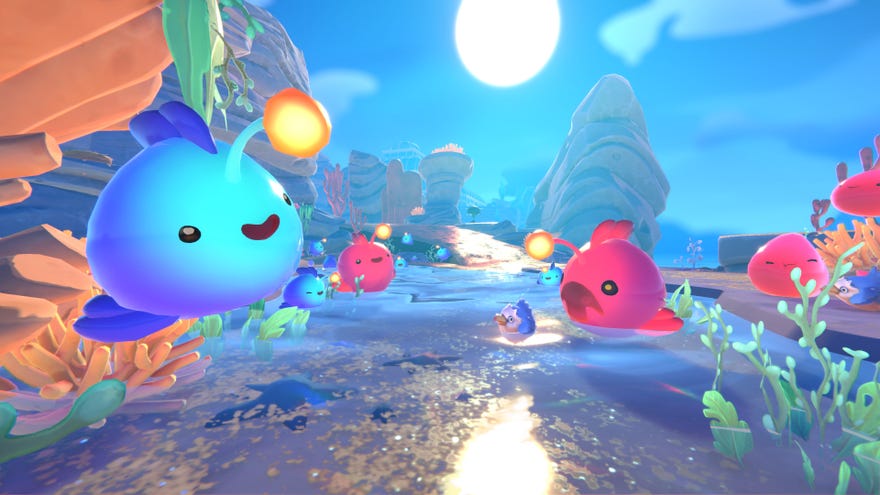"Like a PC game that Nintendo would have made": the making of Slime Rancher (and Slime Rancher 2)
Monomi Park co-founder Nick Popovich talks the farming-sim smash and its wildly successful sequel
When Nick Popovich was a kid, his parents ran the Sprague Road Tavern in North Royalton, Ohio. "Everything was a dive bar," Popovich, now co-founder and CEO of Monomi Park, says of the drinking scene in the Cleveland suburb. "It was all working-class, like dive-bar kinda thing. Which is basically what this place was." His mum and dad wanted to do up the joint, make it into something resembling what today would be called a sports bar. As part of this plan, Popovich's father added a game room to the building, filled with pool tables, shuffleboard ("As a result I'm hugely into shuffleboard", Popovich notes) and most importantly of all, a rotating stock of arcade machines.
Back in the day, explains Popovich, the cabinet was the expensive thing. So his dad would find a cheap cabinet, they'd put in a cheap second-hand board and monitor, and paint the outside to make it look like the official version of the game. To the regulars drinking and shooting pool, it didn't matter that the arcade cabinet looked like a bootleg – that Donkey Kong was just a picture of a monkey that Popovich Senior had stencilled onto the side of the cabinet. What mattered was that the cabinet did what it needed to do, and that the game inside was legit. This line of thinking, of making something only as good as it needs to be, was an essential component in the development of Slime Rancher, Monomi Park's massively successful sci-fi farming simulator. "The original Slime Rancher cheated. A very small group of people made it, and it looks like many more people than that made it," Popovich says.
As may be unsurprising when your garage is filled with arcade machines cycled out of your parents' sports bar, Popovich grew up fascinated by video games, and decided early on that he wanted to spend his life making them. He went to college with a view to becoming a game developer, but in the early 2000s there was no obvious career path into the industry. So Popovich studied 3D art at Ohio's Bowling Green State University, before joining Three Rings Design as an artist, where he transitioned into design and, he says, probably made a lot of mistakes that someone else paid for. "I owe Daniel James and Michael Bayne my career because they took a chance on me that they absolutely should not have."
"At the end of the day, I just wanted to make Slime Rancher, because it was funny."
Popovich was lead designer on 2011's Spiral Knights, a massively multiplayer action game that would later prove influential in Slime Rancher's design. After it launched Popovich decided that, after a decade at Three Rings, it was time to go his own way. Popovich had a bunch of ideas about games he wanted to make, creating a spreadsheet that assessed the potential risks of each one. There was one idea he couldn't shake. "At the end of the day, I just wanted to make Slime Rancher, because it was funny," he says. "And it was also first-person, I'd never done that before. It was using physics, I'd never done that before. So it was interesting."
Popovich says the idea "just popped into my head whole one day," but looking back he reckons the concept was at least partly influenced by the film Gremlins. "I liked that you had these cute creatures that you had to take care off, unless you don't follow the rules, and then it turns very bad," he says. Meanwhile, Slime Rancher's nonviolent FPS mechanics were inspired by a bug in The Elder Scrolls IV: Oblivion that let players "infinitely shoot" random objects using a bow. "So you got a bow that was just a firehose, filling the environment full of melons. Like you go to an inn and start a fight and then just melons, and everyone's struggling to move," Popovich explains. "So I was like 'oh, a ball-pit simulator would be really fun'."
Popovich built a prototype and took it to a former colleague at Three Rings, Mike Thomas, who Popovich persuaded to sign onto the project. Together they spent the next eighteen months developing Slime Rancher, and Popovich says they did that with no crunch, working a year-and-a-half of 9-5 (or 10-6) days. In sticking to this rule, Popovich and Thomas adopted a highly practical approach to design, that "do only what it needs to work" philosophy that Popovich's father had when building his arcade machines.
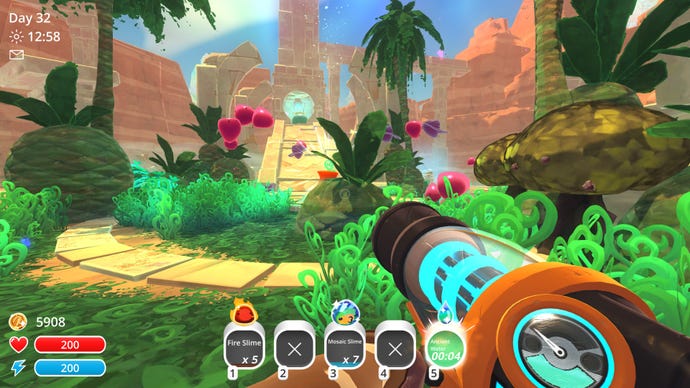
For example, Popovich settled on slimes as the subject of the game partly because they require no animation. "Even when the slimes are wrong, they look right," he says. "Had Slime Rancher been cats, cats need to walk, cats need to adhere to the ground, cats need to not be upside-down in a tree and vibrating," he says. "Whereas if the slime is upside down and stuck in a tree and shaking and smiling… it's funny, right?" Similarly, the simulation governing player interactions with the slimes and the ranch is "as deep as it needs to be", according to Popovich. "Slime Rancher was not a great farming game. It's so shallow compared to other farming games in terms of the number of decisions you're making," Popovich says. "And we have just enough shallow systems that talk to each other in interesting enough ways."
Another crucial component of Slime Rancher's design is that those interactions are always externalised. One example of this is the "plort" mechanic, where slimes drop valuable gem-like objects when fed, which can then be sold by the player for cash. "We could have had it where when you feed slimes you just get points. But whenever possible, we try and have it happen in the world," Popovich expains. On the subject of plorts, Popovich is keen to straighten something out. "I'm not at all defensive about it, but it's not really meant to be poop," he says. "It's almost like they were budding off portions of themselves, and they expand and like pieces of them come out. But of course, it reads as poop, because it's a non-sentient lump of themselves."
This isn't the only clarification Popovich wants to make about Slime Rancher either. Because of its appearance and (mostly) nonviolent play, Slime Rancher has earned a reputation as a kids' game. But Popovich is keen to stress that the game was never targeted towards children. Instead, the intent was to make a game that welcomed everyone. "With our games, we are pro-inclusivity. We want to make it as open as possible, we want to have as many different kinds of people able to play it," he says. "It's also a smart business decision. Like, why wouldn't I want the other fifty percent of players out there, let's say, to feel like they're welcome to buy this game?"
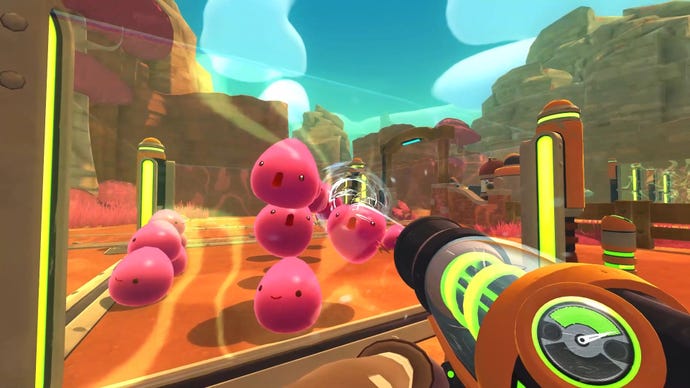
This inclusive approach isn't just about making the game look cute and colourful; Popovich wanted players to learn how to play through their own curiosity, rather than mandated instruction. "That's why the tutorial is like a minute and a half long," he says. "You really can vacuum out the magic of a world but putting in a bunch of structure. That's one of the reasons why so many Nintendo games are so popular. You get to play with it first. We have always tried to do that. Maybe [I'm] being a bit presumptuous here, but I would love it if someone who plays Slime Rancher is like 'this feels like a PC game that Nintendo would have made.'"
Signs Slime Rancher would be a hit came as early as 2015, when the game started to gain traction on Steam Greenlight. Monomi Park gave the game to some YouTubers, but the first version of the game was so small (less than 20 megabytes) it got passed around the internet in email attachments. "Normally you'd be freaking out," Popovich says, but his previous experience in the industry told him this word-of-mouth sharing was a good thing. "We have to accept some level of piracy," he says. "This is a really strong sign that people want it this bad." When the game launched into Steam Early Access, it was an instant hit. "It exploded immediately," Popovich says. "I was texting my wife, who was still at work, because you could see the numbers in real-time. And she was baffled."
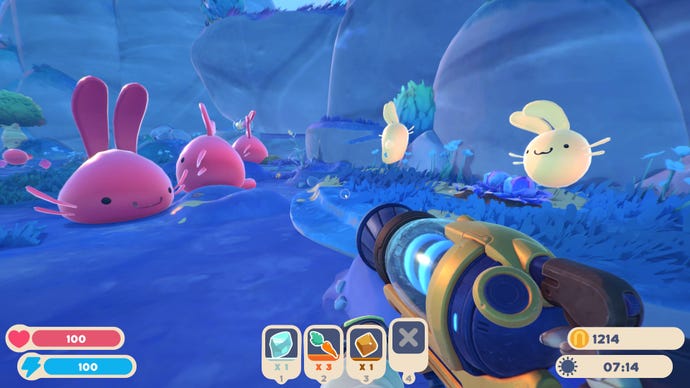
Slime Rancher was a major success, and the next few years saw Monomi Park building on that, delivering Slime Rancher out of Early Access, and supporting it post v1.0. In an ideal world, they would have continued supporting it for much longer. "We try to run our games forever, because we came from MMOs", Popovich says. But two things prevented that. First, they reached a hard limit on new environments and content they could add to the game without completely restructuring it. Second, Monomi had grown into a much larger studio than it had been during Slime Rancher's early days. "You can't take a new team and say 'these decisions that two people made in 2014 are what you're chained to.'"
Hence, Monomi Park opted to build a new version of the game, one that could serve as a platform for all the stuff Popovich wanted to add to Slime Rancher, but couldn't. It also gave them the opportunity to let their new team breathe their own talent into the game. "That's why Slime Rancher 2 is this huge graphical leap over one, because the engineers and artists had new ideas," he says.
Presentation has been a bit of a bugbear for Popovich, not because he thought the first game looked bad, but because a lot of people expected Slime Rancher to run on a potato due to its cute graphics. But the game's colourful presentation belies the heavy physics cost of rendering all those slimes. "There are hundreds of real physics actors in the environment, which even the heaviest of AAA releases will not emulate, because you'd be crazy to do that," Popovich says. "Slime Rancher 1 is easily equal to Kerbal [Space Program] in terms of the physics simulation."

With Slime Rancher 2, Monomi wanted to make the game look as impressive as the technology that supports it, which is why Rainbow Island is such a dazzling bit of visual design. "It's a pastel first-person shooter," Popovich says. "Any one rock, even if its grey, you get up close to it and there's like 12 different colours in it. It was all a conscious decision that there are rainbows in everything." Unfortunately, this hasn't stopped people from complaining about performance. "Some of the feedback we get, it's like, 'why can't this run on my Chromebook or whatever," he says. "It's simulating real-time light, refractions and liquid. It's doing all the things that your AAA games are doing."
The other initial goal Monomi Park had with Slime Rancher 2 was, of course, to add new slimes. But this posed a significant challenge. Slime Rancher allows players to combine slimes to form "Largo" slimes that exhibit physicals features of both slimes like wings, antenna, and so forth. But there are only so many points to place such features on what is essentially a moving sphere, which makes accounting for the many different permutations every new slime adds difficult. "In the case of wings, one of our slimes owns the wings spot. That doesn't mean other slimes can't have wings. When we introduce new ones with wings, it just means those wings have to be at a different place, and one goes or the other when the Largo is formed," Popovich says. "We have a system that will combine the slimes automatically. But that's just the starting point, we then have to go in by hand for every single one, and it is hundreds at this point."
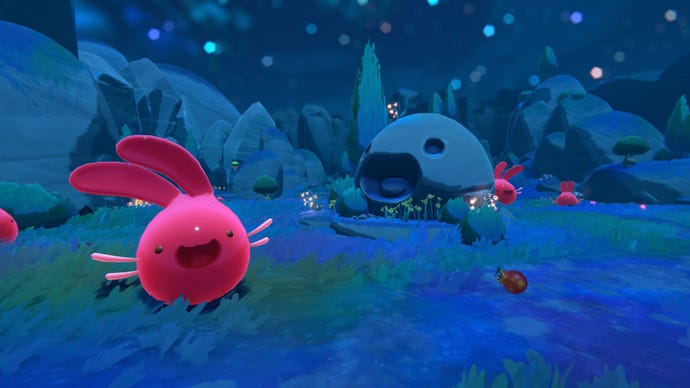
Beyond these two features, Slime Rancher 2 doesn't stray too far from the formula laid out in the first game. Popovich explains this is a deliberate decision. Not simply in a "if it ain't broke" sense, but because Slime Rancher 2's early access launch is merely the foundation upon which Monomi plans to build a game that will keep players entertained for years. "We're going to slowly start introducing new stuff over time. You probably can see in game right now where a change will occur. Because if you play all the way up to the labyrinth wall, you are basically stopped in the world from going any further," he says. "And it should be pretty obvious where some of that change will occur once we can advance further into the game."
Crucially, Monomi has the resources to support Slime Rancher 2 for years. The sequel has dwarfed the success of the original, selling on its first day what Slime Rancher 1 took nine months to sell. "I'm still shocked over it," says Popovich, sounding somewhere between dazed and giddy, "but it bodes very well. We already courted quite an audience. And for all the updates and stuff that we have planned, we'll be able to give them a pretty good experience in this journey through Early Access."
